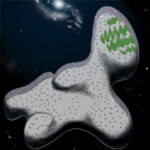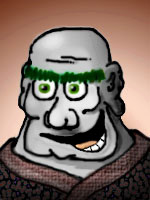The Veelab Species

Overview
The Veelab species is an alien culture which evolved on a jovian planet’s largest moon—a frigid, barren planetoid with nearly no atmosphere and a primarily metal crust. Scraping themselves up from the primordial ooze of their dim-witted ancestry, the Veelab learned to shape their bodies—and the bodies of their vanquished cousins—to resist the rigors of the wasted planet. Since developing space flight, they have gone on to colonize other “ice ball” planets, asteroids, and even some comets.
Veelab are intelligent, shape-shifting, colloid-based blobs that live in massive, planet-encompassing colonies which they call “Choruses.” They are able to thrive in the harsh climes of their origins (as well as in those humans would call “tropical desert”) through careful physical cooperation and a strict class system that is a combination of theocracy and coral reef.
Each Veelabling is trained from the moment it leaves its birthing vestibule to perform one of four primary duties for The Chorus (also called a planet-being):
- morph into a wide vacuum-tight panel, absorbing sunlight while sealing the planet-being from hard radiation and pressure (called “Guarders”);
- flex and climb about the planet-being, transferring liquids and mitochondria-like energy cells to the other classes (called “Gilders”);
- manipulate crust materials to construct objects and morph its own body to supports the kilometers-deep mass of the planet-being (called “Girders”);
- conduct off-planet missions in search of knowledge and sensations, morphing into forms acceptable to the source species or necessary for survival (called “Æsthetes”).
Most Veelab spend their entire 100 year adult lives in service of—and in harmony with—The Chorus, never knowing any sensation other than the slippery, warm pressure of neighboring Girders or the sticky sweetness of passing Gilders. They use “The Song” to keep in touch with the rest of the planet-being—a constant background harmonic vibration through the entire world that is communication system, legislature, educational system, and theatre simultaneously. Each Chorus comes the closest any culture of living things can to being a gestalt mind. Not a hive mind: each Veelab is as individual as a snowflake, within the context of its main social role.
The role of the highly-adaptable Æsthete class is that of diplomat, purchasing agent, and poet laureate for its Chorus. Bred as a mingling of each Veelab class, they are morphable as Gilders, yet capable of being as resilient and photo-sensitive as Guarders. As soon as it is ready, each Æsthete Veelab is equipped only with its Vod-dpah and sent forth to travel the stars, find the unique and engaging and “un-Veelab,” and return with Songs of it to its Chorus….
Sizes
| Guarders | ~150kg, 2m3 (9m2 x 4cm thick and rigid when Guarding) |
| Gilders | ~90kg, 1.5m3 to 3m3 (amorphous gel when Gilding) |
| Girders | ~80kg, 1 m3 (rigid tetrahedral lattice when Girding) |
| Æsthete | ~130kg, 1.5m3 to 3m3 (amorphous and variably textured) |
Senses
| Guarders | Photosynthetic receptors can be arrayed for rudimentary sight in the “mid-blue” to ultraviolet range of the spectrum. |
| Gilders | “Mitochondria-like” organelles can be arrayed for rudimentary sight in the infrared range of the spectrum. |
| Girders | “Mitochondria-like” organelles can be arrayed for rudimentary sight in the infrared range of the spectrum. Internal “motion-sensor” organelles provide extreme vibration sensitivity. |
| Æsthete | Photosynthetic receptors can be arrayed for very poor sight in the “mid-blue” to ultraviolet range of visible light. “Mitochondria-like” organelles can be arrayed for rudimentary sight in the infrared range of the spectrum. |
| All | Endoplasm can be made sensitive enough to hear extremely low and high frequency vibrations. Endoplasm can be made malleable enough to feel very subtle textures. Absorbed chemicals can be discriminated with a canine’s sense of smell/taste. |
Ingestion
| Guarders | Light and nitrogen (N2) for photosynthesis (can transfer heat energy to Gilders). |
| Gilders and Girders | Heat energy and oxygen (O2) (transfer heat energy freely to other Veelab). |
| Æsthete | Heat energy, chemical energy (internal absorption of cellular matter), light, O2, H2, and/or N2 —depending upon whether using photosynthesis, digestion, respirations, or a combination. |
Reproduction
From one to eight (this is considered by Veelab to be only a reasonable limit, not a theoretical one) non-Æsthete Veelab enter a birthing vestibule. They leave later. Don’t ask for further details. Two years later, a Veelabling emerges, already partly pre-disposed to a certain Veelab sub-physiology.
Lifecycle
Gestation in two years, maturation and primary education in ten years, adult for 100 years, “Sat-Tya-Tsin” (roamer within the planet-being) for remaining twenty to forty years of life. Consumed by Gilders upon death.
Psychology
All but the Æsthete class are shy and avoid non-Veelab, but they are generally understood to be reserved, contemplative, slow-going beings.
The Æsthete Veelab, however, are gregarious, out-going, boisterous, and brash. Since they are always questing for the unique, sublime, or exciting, they are driven and energetic to a fault. Coupled with their tendencies to be obsessive about a particular field of research or art, they can be exhausting companions. Their confidence and competence in times of crisis, however, offsets their madcap natures often enough to make them valuable allies.
Technology
The Veelab have developed extensive architectural, sonic, and chemical sciences, but their physical adaptability dissuades them from expanding sciences into—for them—useless areas. Their principle unique development, in the space sciences, is the Vod-dpah: a semi-symbiotic device that is a collection of metal tubes, genengineered sacs, and polymer bottles that resembles nothing so much as a bagpipe designed by H.R. Geiger.
A Vod-dpah is usable only by Veelab because they must absorb portions of the Vod-dpah into its body, leaving certain tubes and sacs exposed. With this configuration, the Vod-dpah will allow a Veelab to jet powerful (or not), heated (or not) gases in complex sequences. This mechanism can be used as a flame-throwing weapon, a jet-pack (in low gravities), a welding tool, a cutting tool, and even a life-support system (for Veelab and species with similar heat, pressure, and air requirements). It also contains a basic multimedia recording computer and large data storage cells (which interface directly with the Veelab’s sensorium, for maximum fidelity). With it, an Æsthete or Guarder Veelab can break from the gravity of a planet-being’s world and patrol nearby space (as long as it, of course, morphs its endoplasm into a pressure seal). It is in this way that Veelab Æsthetes can reach orbital facilities, where they morph into humanoid form to conduct business (and pleasure) in the Lattice.
Communication
Ultra- to hyper-sonic transmission and echoing across the whole planet (similar to whales of Earth). “Touch” language of the Veelab (unique, requires shape-shifting ability to attain fluency). Limited radio and light communications system for solar-system-wide comms (anything more interferes with The Song).
Culture
As near to a gestalt mind as possible without telepathy. Religion, government, entertainment, family, commerce, strife: for the Veelab, all this occurs in The Song of The Chorus. Few Veelab can be away from their Chorus for long. Few want to be.
They colonize only as space for a new Chorus is needed. They do all that they can to avoid warfare with other species, since they are very vulnerable as planet-beings. For this reason—and to encourage hospitality for their Æsthetes—they make scandalously goods deals on the music, sculpture, and chemicals that they export to the other races of the Lattice. This generosity (and the quality of their goods) encourages most of the peoples of the Lattice to give Veelab planet-beings a wide berth, and their emissaries a comfortable trip through the Worlds.
Hyt-tyl-tyl-bas (“Number Twenty-Four”)
Æsthete of the Segillut-4 Chorus

Age – 20 Standard Years physical / 72 Relative Years actual
Mass – 120kg
Typical Appearance– Stocky, gray-skinned male humanoid, bald, with huge green eyes and bushy-seeming green eyebrows (both are, in fact, clusters of photosensitive organelles pushed near to his skin).
Base or Relaxed Appearance – Translucent to transparent, milky gelatinous mass with small, granular organelles floating around inside.
Abilities
Each Æsthete Veelabling is trained in the Common language, diplomacy, history, music, and art.
Equipped with, and trained in the use of, the Veelab Vod-dpah (see Veelab Species above).
At A Glance
Æsthete Hyt-tyl-tyl-bas is a “typical” Veelab Æsthete. He (for lack of a suitable gender pronoun) is on tour in the Lattice, gathering sensations and songs for his home Chorus. Though he has no itinerary, per se, he hopes to enrich his planet-being’s knowledge of current events in the “neighborhood,” and will thus seek out “hot spots” rather than “centers of culture” when given a choice.
An eager Æsthete, Hyt-tyl-tyl-bas has a zest for life that borders on seeming lunacy. He tends towards overzealous pursuit of excitement and adventure, often at great risk without ever realizing it. He is jocular, overly-trusting, noisy, and often brash—but generally endearing more than annoying to those whom he befriends. If any part of his personality could be said to be “dark” or “closed,” it is his attitude towards his Vod-dpah: he is terrified of its destructive potential and avoids it being seen by the public, least they fear him as much as he fears it. He uses it only when he must, and has yet to use it on a living being.
Strengths
|
Weaknesses
|
It would seem I was prescient:
http://www.nature.com/news/2010/100224/full/news.2010.90.html